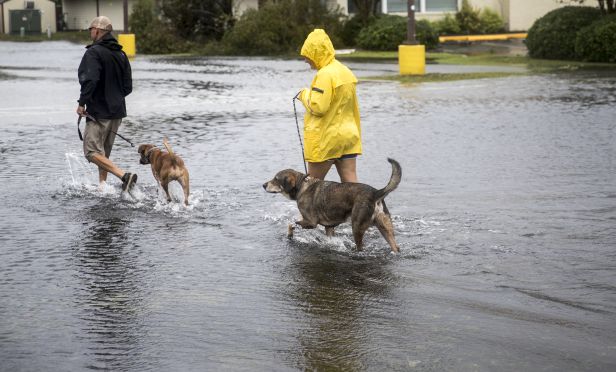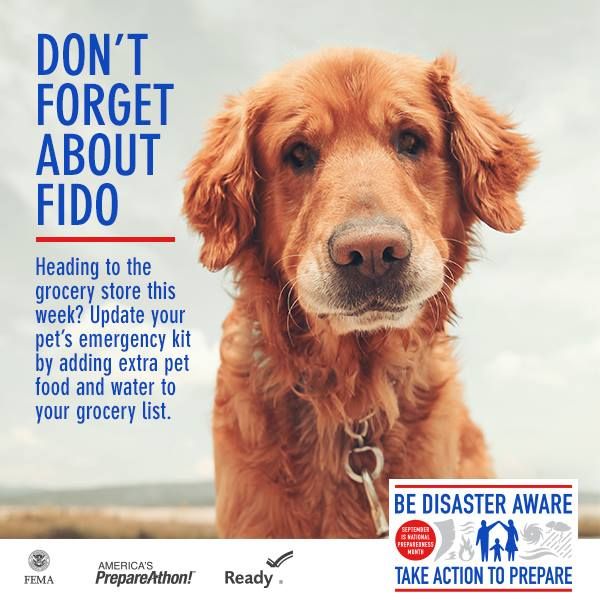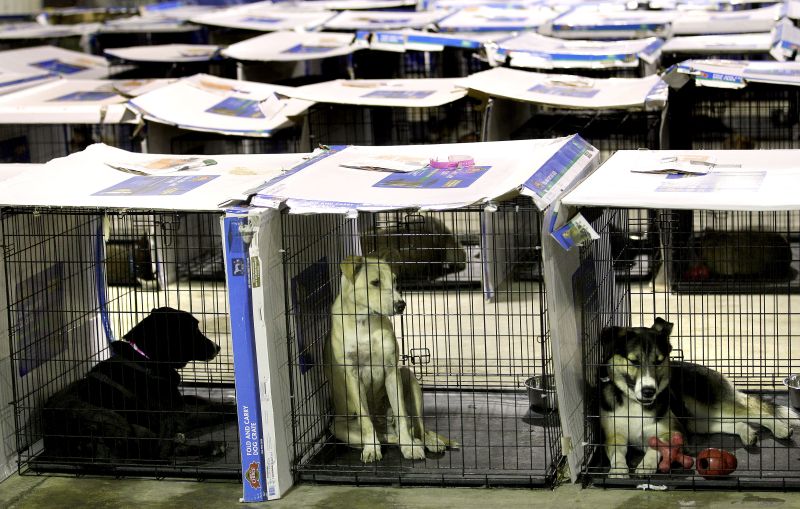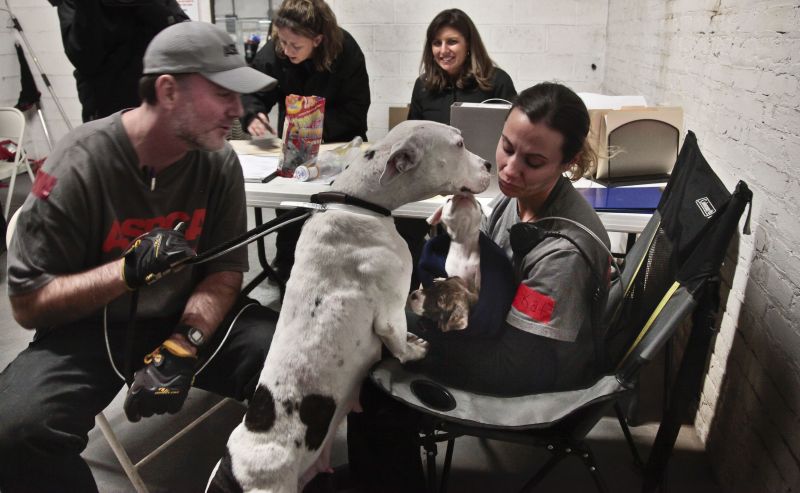 Pedestrians cross a flooded parking lot after Hurricane Florence in Wilmington, North Carolina, on Saturday, Sept. 15, 2018. (Photo: Alex Wroblewski/Bloomberg)
Pedestrians cross a flooded parking lot after Hurricane Florence in Wilmington, North Carolina, on Saturday, Sept. 15, 2018. (Photo: Alex Wroblewski/Bloomberg)
Many pets become lost or separated from their families during storms or other disasters.
The U.S. Department of Homeland Security and the Federal Emergency Management Agency, sponsors of Ready.gov, want you to include your cat, dog or other animals in your disaster preparedness plans.
Recommended For You
Lessons from Katrina
During Hurricane Katrina in 2005, tens of thousand of animals were left behind to fend for themselves because no provision had been make for the evacuation of pets along with families. One survey conducted after Katrina found that 44% of those who chose to ride out the storm did so because they could not evacuate with their animals, according to CNN.
The Louisiana Society for the Prevention of Cruelty to Animals estimates that as many as 104,000 pets remained in New Orleans during the storm. Of those, about 15,500 were rescued but only about 15% to 20% of the rescued animals were reunited with their owners. At least 88,700 pets were unaccounted for. Most estimates put the number of animals who died during Katrina between 50,000 and 70,000 across the entire Gulf Coast.
PETS Act
In 2006, Congress passed the Pet Evacuation and Transportation Standards Act, which required local jurisdictions to have a pet evacuation plan in place to qualify for FEMA funding in the event of a disaster. The PETS Act has saved countless animal lives in subsequent disasters and reflects the public understanding that pets are indeed a part of the family.
The Humane Society of the United States reminds us, "If you are told to evacuate, leave immediately and take your animals. If it's not safe for you, it's not for them."
Here are helpful tips to share with your insurance clients on how to make sure pets are prepared and safe in case of the next natural disaster or other emergency:
 Jessie Pullins and his dog, J.J., on the steps of their home in New Orleans, June 3, 2009. Pullins was reunited with J.J. after almost a four-year separation because of Hurricane Katrina. His fight to be reunited with his pet is portrayed in "Mine," a documentary. (Photo: Bill Haber/AP Photo)
Jessie Pullins and his dog, J.J., on the steps of their home in New Orleans, June 3, 2009. Pullins was reunited with J.J. after almost a four-year separation because of Hurricane Katrina. His fight to be reunited with his pet is portrayed in "Mine," a documentary. (Photo: Bill Haber/AP Photo) ID your pet
Make sure your pet's tags are up-to-date and securely fastened to your pet's collar. If possible, attach the address and/or phone number of your evacuation site. If your pet gets lost, the tag greatly increases your chances of being reunited with your pet.
Talk to your veterinarian about microchipping. If you and your pet are separated, this permanent implant for your pet and corresponding enrollment in a recovery database can help a veterinarian or shelter identify your animal. If your pet is microchipped, keeping your emergency contact information up-to-date and listed with a reliable recovery database is essential to you and your pet being reunited.
Remember, the average citizen who finds your pet won't be able to scan for a chip, but they will probably be able to read a basic tag.
Related: The 5 rules for keeping pets safe in a natural disaster
 (Graphic: FEMA)
(Graphic: FEMA) Create a pet emergency kit
If you have a companion animal, get ready now for possible emergencies by creating a kit of pet supplies. The kit should include the basics for your pet's survival.
- Food: Keep at lest three days of food in an airtight, waterproof container.
- Water: Store at least three days of water specifically for your pets, in addition to water you need for yourself and your family.
- Medicines and medical records: Keep an extra supply of medicines your pet takes on a regular basis in a waterproof container.
- First aid kit: Talk to your veterinarian about what is most appropriate for your pet's emergency medical needs. Most kits should include:
-
- Cotton bandage rolls.
- Bandage tape and scissors.
- Antibiotic ointment.
- Flea and tick prevention.
- Latex gloves.
- Isopropyl alcohol.
- Saline solution.
- Pet first aid reference book.
-
- Collar with ID tag, harness or leash: Your pet should wear a collar with its rabies tag and identification at all times. Include a backup leash, collar and ID tag in you pet's emergency supply kit.
- Important documents: Place copies of your pet's registration information, adoption papers, vaccination documents and medical records in a clean plastic bag or waterproof container and also add them to your kit.
- Crate or other pet carrier: If you need to evacuate in an emergency situation, take your pets and animals with you, provided that it is practical to do so.
- Sanitation: Include pet litter and litter box if appropriate, newspapers, paper towels, plastic trash bags and household chlorine bleach to provide for your pet's sanitation needs. You can use bleach as a disinfectant (dilute 9 parts water to 1 part bleach), or in an emergency you can also use it to purify water. Use 8 drops of regular household liquid bleach per gallon of water, stir well and let it stand for 30 minutes before use. Don't use scented or color safe bleaches or those with added cleaners.
- A picture of you and your pet together: If you become separated from your pet during an emergency, a picture of you and your pet together will help you document ownership and allow others to assist you in identifying your pet. Include detailed information about species, breed, age, sex, color and distinguishing characteristics.
- Familiar items: Put favorite toys, treats or bedding in your kit. Familiar items can help reduce stress for your pet.
Suggestion: Consider preparing two kits. In one, put everything your pets will need to stay where you are in an emergency. The other kit should be a lightweight, smaller version you can take with you if you and your pets have to evacuate in a hurry.
 In this June 14, 2011, file photo, rescued dogs sit in their kennels at a shelter in Joplin, Mo. after surviving an EF-5 tornado that ripped through the city three weeks earlier. Shelter and care for more than 1,300 pets left homeless by the twister accounted for $371,857 of the $500 million in taxpayer assistance provided after the costliest tornado on record. (Photo: Charlie Riedel/AP Photo)
In this June 14, 2011, file photo, rescued dogs sit in their kennels at a shelter in Joplin, Mo. after surviving an EF-5 tornado that ripped through the city three weeks earlier. Shelter and care for more than 1,300 pets left homeless by the twister accounted for $371,857 of the $500 million in taxpayer assistance provided after the costliest tornado on record. (Photo: Charlie Riedel/AP Photo) Make a plan
Plan in advance what you'll do in an emergency to ensure your pet's safety.
Evacuate. Plan how you'll gather your pets and anticipate where you'll go. If you must evacuate, take your pets with you, if practical. If you go to a public shelter, keep in mind your pets may not be allowed inside.
Secure appropriate lodging in advance depending on the number and type of your animals. Consider family or friends outside your immediate area who would be willing to take in you and your pets in an emergency.
Other options may include: a hotel or motel that takes pets or some sort of boarding facility, such as a kennel or veterinary hospital that is near an evacuation facility or your family's meeting place. Find out before an emergency happens if any of these facilities in your area might be viable options for you and your pets.
Develop a buddy system. Plan with neighbors, friends or relatives to make sure that someone is available to care for or evacuate your pets if you are unable to do so. Talk with your pet care buddy about your evacuation plans and show them where you keep your pet's emergency supply kit. Also designate specific locations, one in your immediate neighborhood and other farther away, where you will meet in an emergency.
Talk to your pet's veterinarian about emergency planning. Discuss the types of things you should include in your pet's emergency first aid kit. Get the names of vets or veterinary hospitals in other cities where you might need to seek temporary shelter.
Gather contact information for emergency animal treatment. Make a list of contact information and addresses of area animal control agencies including the Humane Society or ASPCA and emergency veterinary hospitals. Keep one copy of these phone numbers with you, and one in your pet's emergency supply kit.
Obtain "Pets Inside" stickers and place them on your doors or windows, including information on the number and types of pets in your home to alert firefighters and rescue workers. Consider putting a phone number on the sticker where you could be reached in an emergency. And, if time permits, remember to write the words "Evacuated with Pets" across the stickers, should you evacuate your home with your pets.
 Bruce Earnest, far left, an animal handler, and Dr. Katherine Miller, far right, a behaviorist, both with the ASPCA, prepare to shelter Nayla, a mix pitbull, and her pups on Nov. 17, 2012 at an emergency boarding facility in the Brooklyn borough of New York. The temporary warehouse facility, located at 1508 Herkimer St. in the Bedford-Stuyvesant neighborhood was made possible by a $500,000 grant provided by television personality Rachael Ray to shelter animals displaced by Superstorm Sandy. (Photo: Bebeto Matthews/AP Photo)
Bruce Earnest, far left, an animal handler, and Dr. Katherine Miller, far right, a behaviorist, both with the ASPCA, prepare to shelter Nayla, a mix pitbull, and her pups on Nov. 17, 2012 at an emergency boarding facility in the Brooklyn borough of New York. The temporary warehouse facility, located at 1508 Herkimer St. in the Bedford-Stuyvesant neighborhood was made possible by a $500,000 grant provided by television personality Rachael Ray to shelter animals displaced by Superstorm Sandy. (Photo: Bebeto Matthews/AP Photo) How to protect your pet during a disaster
- Bring your pets inside immediately.
- Have newspapers on hand for sanitary purposes. Feed animals moist or canned food so they will need less water to drink.
- Animals have instincts about severe weather changes and will often isolate themselves if they are afraid. Bringing them inside early can stop them from running away. Never leave a pet outside or tied up during a storm.
- Separate dogs and cats. Even if your dogs and cats normally get along, the anxiety of an emergency situation can cause pets to act irrationally. Keep small pets away from cats and dogs.
- In an emergency, you may have to take your birds with you. Talk with your veterinarian or local pet store about special food dispensers that regulate the amount of food a bird is given. Make sure that the bird is caged and the cage is covered by a thin cloth or sheet to provide security and filtered light.
- If you evacuate your home, don't leave your pets behind! Pets most likely cannot survive on their own, and if by some remote chance they do, you may not be able to find them when you return.
 Luna, a beagle, sits in her makeshift home at an evacuee center on March 24, 2011 in Fukushima, Fukushima prefecture, Japan. (Photo: Wally Santana/AP Photo)
Luna, a beagle, sits in her makeshift home at an evacuee center on March 24, 2011 in Fukushima, Fukushima prefecture, Japan. (Photo: Wally Santana/AP Photo) Caring for your pet after a disaster
- In the first few days after the disaster, leash your pets when they go outside. Always maintain close contact. Familiar scents and landmarks may be altered and your pet may become confused and lost. Also, snakes and other dangerous animals may be brought into the area with flood areas. Downed power lines are a hazard.
- The behavior of your pets may change after an emergency. Normally quiet and friendly pets may become aggressive or defensive. Watch animals closely. Leash dogs and place them in a fenced yard with access to shelter and water.
Related: 8 tips for preventing dog bites
Check out this short video from FEMA and the White House with an important message regarding keeping your beloved pets safe in the event of a natural disaster or emergency.
Got photos to share? We'd like to see them. PropertyCasualty360.com readers who have images of Florence's path can send them via e-mail to [email protected], for inclusion in our coverage.


